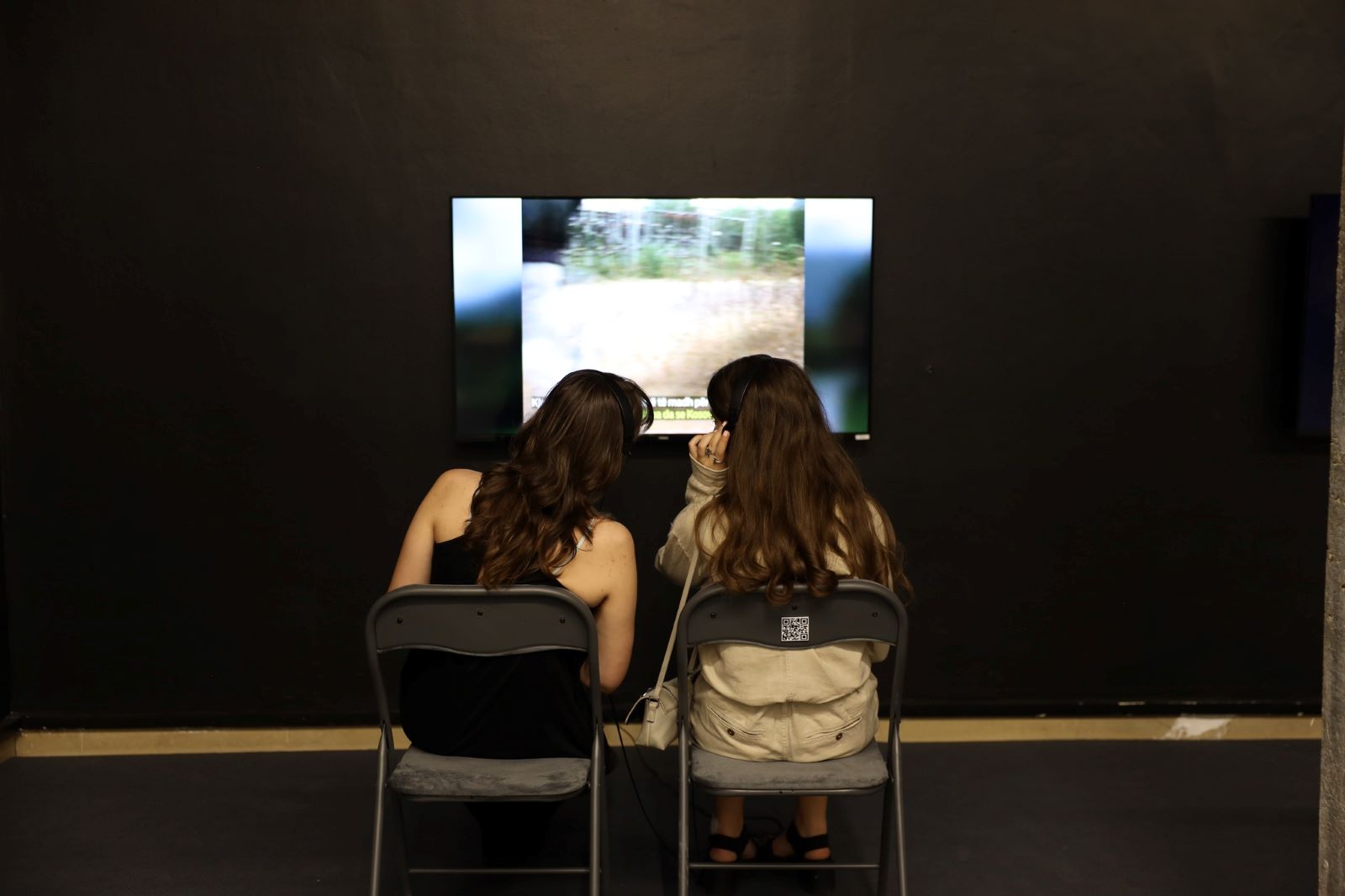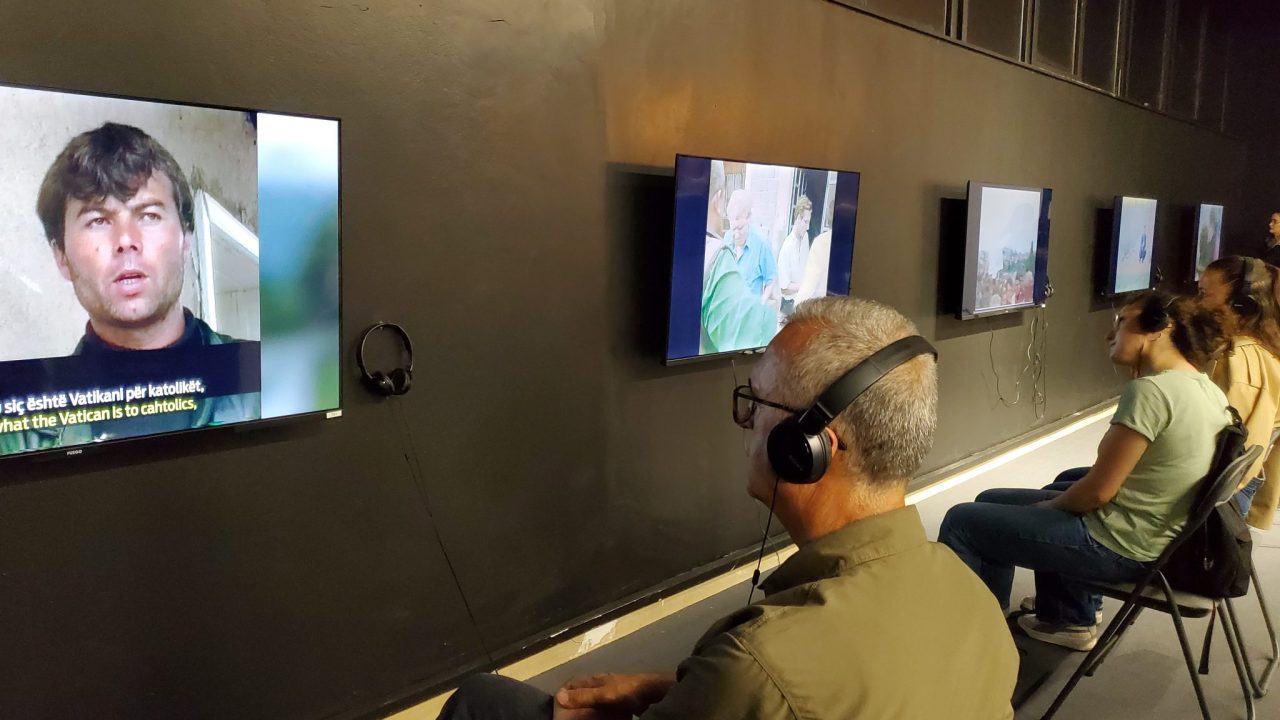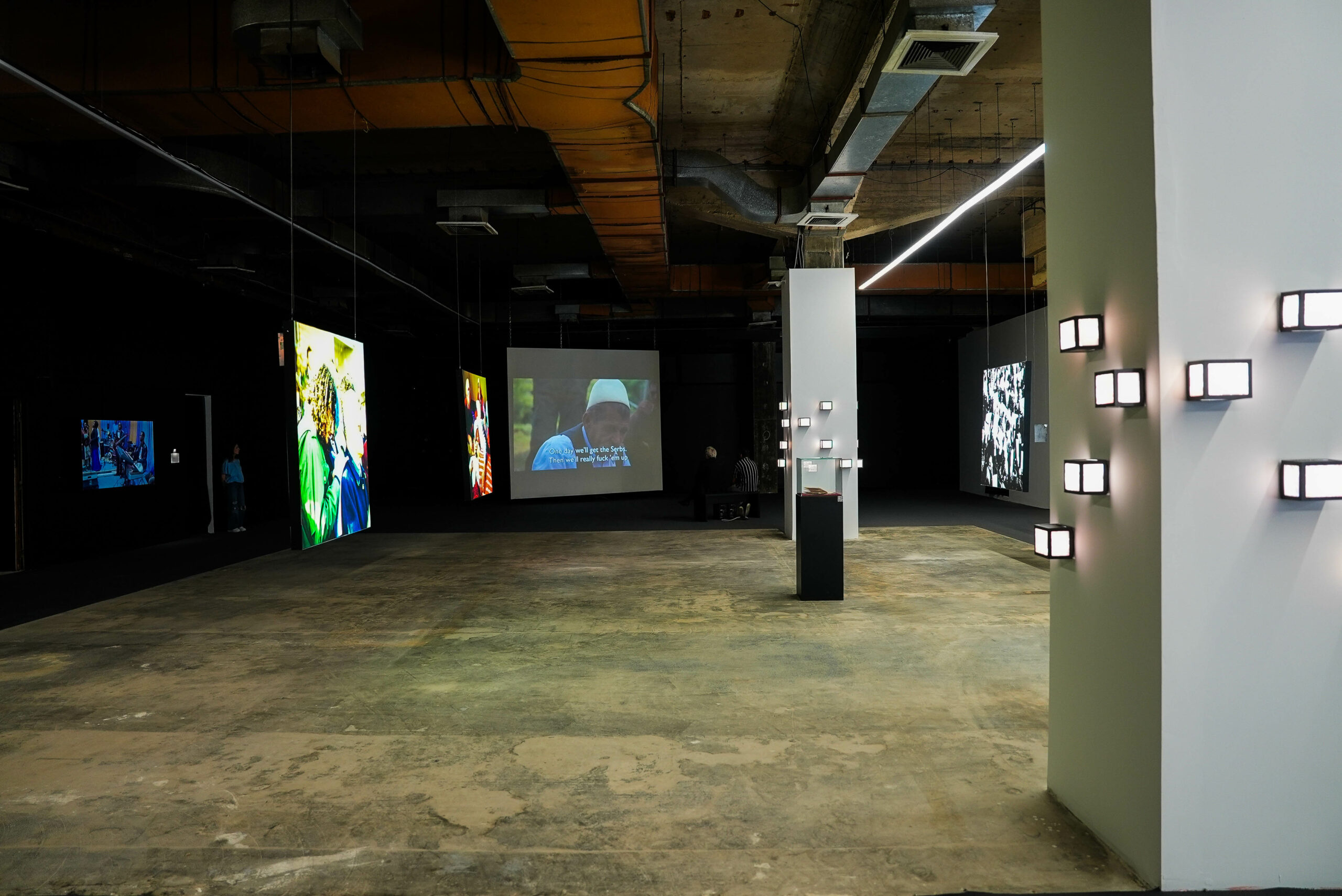BIRN’s Reporting House, a museum to protect Kosovo’s collective memory, gathered thousands of people in Prishtina.
While everyone was counting down the last hours towards the New Year 2025, Reporting House, exhibited in Prishtina, counted thousands of visitors who expressed their interest in the modern history of Kosovo.
Opened on June 10, 2024, marking 25 years of Kosovo’s Liberation Day, Reporting House became a destination for 5,647 visitors from various countries around the world in the last six months of 2024.
The exhibition gathered all those interested in Kosovo’s modern history, marked by the resistance for freedom, documented through journalistic material and contemporary artwork, covering a period from 1989 to the end of 1999 in Kosovo.
Public schools, private colleges, and universities have also shown extraordinary interest. 14 of them visited the Reporting House in the final months of 2024.
On November 28, 2024–Albania’s Independence Day–there were a record-breaking number of visitors with 231 people choosing the Reporting House as a way to celebrate the day.
Located on the first floor of the former “Gërmia” building in Prishtina, Kosovo’s first department store built in 1973, Reporting House has been transformed during 2024 – offering not only factual materials and documentation but also research opportunities for local and international researchers and especially students.
Various public figures, both local and international, visited the museum. Some of them visited more than once, and brought their friends and family members as well.
Below we share some of the visitor’s impressions documented in the “Reporting House guestbook.”
Visitor Impressions:

BIRN’s ‘Reporting House’ exhibition in Prishtina, Kosovo. Photo: BIRN/Naser Fejza
“The entire way this museum–or whatever you want to call it–is organized is truly extraordinary. I think it is incredibly important to come here, especially to bring children to visit this place, because it is history itself, documented–not invented. Documented through photographs and videos,” said Ferid Berisha, a former member of the Kosovo Liberation Army (KLA), known as “Commander Skopje.”
“The exhibition can be seen as a deeper study not only of the war and its consequences but also of the conditions and circumstances that lead to it, as well as the post-war turbulence in Kosovo, contextualizing the events not only within Kosovo but also across the region,” said Penesta Dika, curator, and researcher.
“A bitter, but necessary, reminder of Kosovo’s modern history,” wrote Lavdim Klaiqi on December 12,h 2024.
“This Museum of Historical Resistance, regardless of the periods being displayed, all the exhibits I had the chance to see represent the entire national resistance up to the act of declaring Kosovo an independent and sovereign state,” wrote Ali Ahmeti – leader of the Albanian ethnic political party in Macedonia – BDI, on December 17th, 2024, after his visit.
“Only the truth reconciles nations,” wrote Shpend Gjugja.
“We are in great need of publishing [these] testimonies,” wrote Venera and Diana Gjugja.
“History that is forgotten repeats itself. Once in Kosovo, never again! Bardha Kelmendi and Lis Sllamniku were here.”
“If you wanted to give voice to your history, you have achieved this through ‘Reporting House,’” wrote Alessia and Sara.
“We congratulate you for the initiative of creating this Museum. We hope to have the opportunity to visit the war documentation museum with future generations,” wrote the group of teachers and students from the ‘Kadri Kusari’ primary school in Gjakova.
“The exhibition should remain open forever! The sacrifice and selflessness for the liberation and independence of Kosovo. With great dedication, it must be preserved here at Reporting House. I congratulate you for the collected facts of the last war in Kosovo,” wrote Gurakuq Ukaj from Tetova.
“Important experiences are unfolding; the whole world must see them. Thank you for the exhibition!” wrote Arderisa Rugova from Germany.
“Serbia’s crimes against the people of Kosovo are never forgotten. Glory to the martyrs of the nation!” wrote Esat Mulliqi.

Visitors watching wartime reports. Photo: BIRN/Xhorxhina Bami
“A historical, touching, and extraordinary compilation of footage never seen before. It is a vital presentation of information that I hope will be preserved and archived forever. The professionalism of this exhibition is beyond anything. I have never seen anything like this before, Jeta and Gazmendi should be congratulated. Thank you!” wrote Marc Perry from the United Kingdom.
“Pleasure and nostalgia, the reopening of Germia. Endless childhood memories…” – anonymous.
“Once upon a time, may it never be repeated. As long as the missing are not found, the wounds remains open…” – anonymous.
“Congratulations Prishtina, and greetings from Brazil,” wrote Eges.
“I liked it because I learned about the history of Kosovo and spoke with NATO commander,” – Leka.
“From the first screen to the last, number 15, I found myself and my family within 60 minutes I spent visiting the exhibition. But I can freely say that I will come several more times until I see all the videos on display. I will bring my children to see the terror and experiences of their ancestors, as we were liberated 25 years ago. As a person born in 1983, visiting this museum was not just a visit but a return in time and to the terror. Congratulations to the organizers for this endeavor!” wrote Liridon Shala.
“A deep thanks to all the journalists, photojournalists, cameramen, and everyone who made it possible for the sufferings of the Albanian people to be published in all international media. I thank all those who made this exhibition possible for documenting the facts through the cameramen,” wrote Mefail Bajqinovci.
“The exhibition is based on truths and history of my people. Congratulations for the work you’ve done,” wrote Edi.
“It was a special pleasure for me and the Kosovo Police team to visit Reporting House, the war museum organized by Jeta Xharra and her team…” wrote Gazmend Hoxha, the Director General of the Kosovo Police.
“During the visit to this exhibition, above all, I want to congratulate its organizers. I believe it is very well-timed, and above all, the videos and photos are clear evidence of the suffering of the people in Kosovo. It would be good for our state institutions to archive these materials as evidence and use them in lawsuits against the state of Serbia for the genocide it committed against the Albanian people,” wrote Isak Shabani, a member of the Kosovo Assembly and a survivor of the Dubrava massacre.
“We all lived through the war, but we haven’t seen it in its entirety. We were fighting for our lives. There is still so much for us to see, and today we saw what we need to know well and in detail: the genocidal crime that happened in the heart of Europe,” wrote Tinka Kurti.
“I was amazed and deeply thankful that you brought this artistic spirit, unseen in our country! I am deeply grateful for this work!” wrote Memli Krasniqi, conductor.
“The Reporting House exhibition reveals the history of Kosovo through various periods, many of which were very hard and difficult for the Albanian people. Today, I had the chance to revisit these periods. A special emotion, as well as pride, to see the great work done through this exhibition. The testimonies of the past are what keep our collective memory alive and the events of resistance for our people!” wrote Albulena Haxhiu, Minister of Justice.
“We need locations. Let me say this, my father passed away in 1992, only in 2004 did I manage to find his body, and in 2005 we buried him. The years from 1992 to 2005 were terrifying; inside me was a black abyss. People need locations. They need graves, they need places like this [museum], because they are necessary for us to go…. I had a meeting with your Head of Parliament and I told him, you need to centralize the collective memory, the narrative, the history. You need to tell the full story, in a coherent and meaningful way, in a way that preserves your identity. We are who we are because of what we have been through,” said Emir Suljagic, a survivor of the Srebrenica genocide and the director of the Srebrenica Memorial Center in Bosnia and Herzegovina.
A small step, to prevent forgetting

Reporting House Exhibition in Prishtina, Kosovo: Photo/BIRN
Reporting House is a project realized by BIRN in Kosovo and Kallxo.com, with producer Jeta Xharra, “Paper Gallery,” and “Prishtina Biennale,” and curated by art professor Gazmend Ejupi. In total, the museum documents over 30 hours of video material, photographs, and works of art by eight different artists, both Albanian and international.
Jeta Xharra, a journalist and the creator of this museum (who worked for the BBC during the war) took the initiative to digitize 30 hours of foreign media material reported on Kosovo, as an initiative against forgetting.
“Twenty-five years have passed since the war, and the time has come for us to fight, not only against corruption and injustices, but also against the forgetfulness of what happened in our country. We have opened this modern museum, which in a very contemporary way, without pathos, marks the contribution of the civilian population to the freedom that Kosovo enjoys today,” said Jeta Xharra.
Marking a quarter-century since the end of the war in Kosovo, Reporting House offers the public a detailed reflection of our European war that concluded the 20th century.
The exhibition allows visitors to travel through the conflict that was boiling in the 1990s, from which emerged the guerrilla movement of the Kosovo Liberation Army, which later erupted into war in 1998-1999, culminating in 11 weeks of NATO airstrikes that led to Kosovo’s liberation and its independence in 2008.
The exhibition unveils the first draft of this history written by journalists and demonstrates the central role that the media has played alongside later artistic interpretations of this history. The public is invited to further understand the extraordinary history of Kosovo, whereas the exhibition remains open for collaboration in its further development.
Reporting House presents works by artists from various countries and renewed names from the art world, including Anri Sala from Albania, Adrian Paci from Albania, Goncalo Mabunda from Mozambique, Lala Meredith Vula from England, Zhana Kadyrova from Ukraine, Lana Cmaijcanin from Bosnia and Herzegovina, Olafur Eliasson from Iceland-Denmark, Laura Imami from England, and Besa Llugiqi, as well as young artists like Vullnet Jakupi and Vita Kasapolli from Kosovo.
Gazmend Ejupi, the curator of this exhibition and an art professor at UBT College, is the visionary behind the combination of modern art with journalism, which makes the exhibition so unique.
“We have combined the material from journalists, their photographs and videos, with contemporary artworks that deal with the theme of refugees’ experiences and war in other parts of the world- we have simply made our local experience in this exhibition by curating the works of well-known international artists to be exhibited in the center of Prishtina with an entirely new cultural space,” said Ejupi.
As part of this exhibition, around 150 television reports from global networks are presented, featuring exclusive footage for Kosovo between 1992 and 1999, from BBC, Dar Erste (German public TV), Nippon TV, NHK (Japanese public TV), RTE (Irish Public TV), EO 2 Vandag (Dutch Public TV), Tele 5 (Spanish TV), and Frontline Television News. These reports highlight the work of journalists, photographers, camera operators, translators, and local producers who worked on them.
Contributions to this exhibition include Jeremy Bowen, Ben Brown, Ilaz Bylykbashi, Thomas Dvorzak, Alan Chin, Donika Shahini, Paul Lowe, Max Stahl, Ridvan Slivova, David Loyn, Jehona Lushaku, Besnik Mehmeti, Nik Millard, Andrew Testa, Pal S.Refsdal, Flaka Surroi, Hazir Reka, Marija Ristiq, Fred Scott, Eliza Hoxha, Vaughan Smith, Nora Weller, Sean Whelen, Goran Tomasevic, Sami Mustafa, Alban Bujari, Linda Gusia, Eki Rrahmani, Gazmend Avdiu, Srebrenica Memorial Center, Anibar, Koha Ditore, RTK, and Oral History Kosova.
The majority of the archival television and artifacts were donated by Vaughan Smith from Frontline News Television, who worked in Kosovo from 1998-1999.
The main contribution in transforming the space in this building came from the Municipality of Prishtina, which invested in the museum’s infrastructure, while the main donor for this exhibition was the Dutch Embassy.





